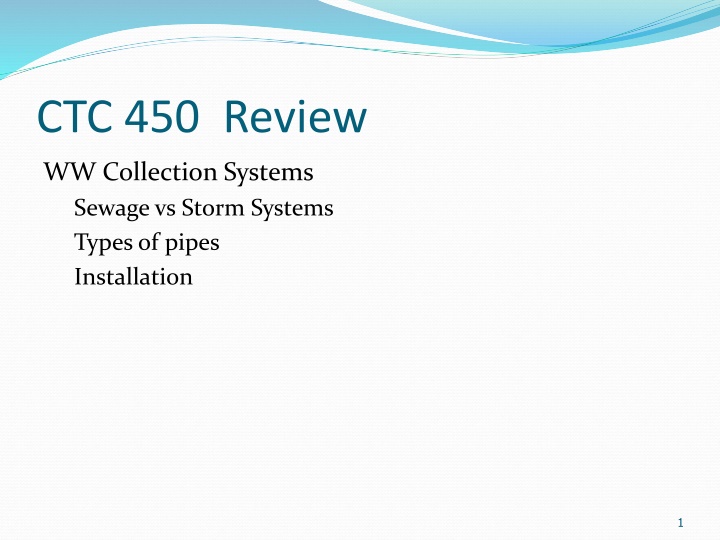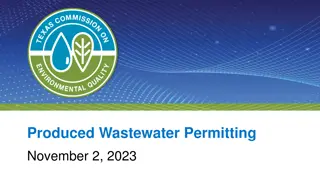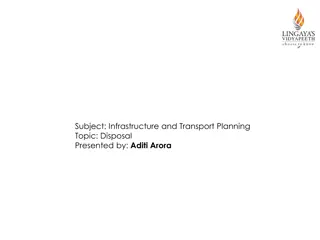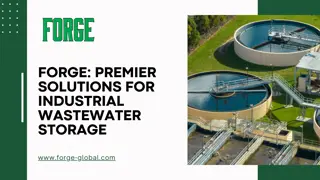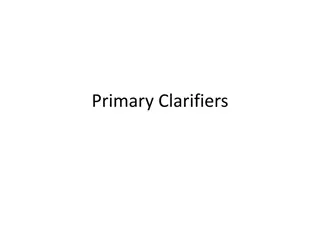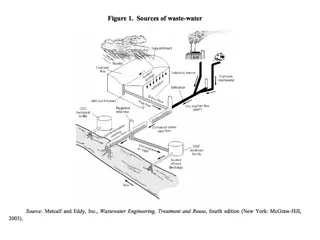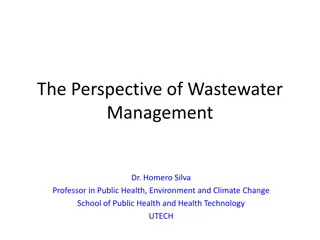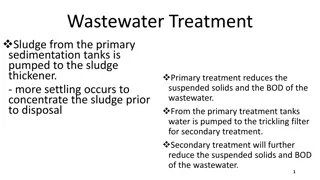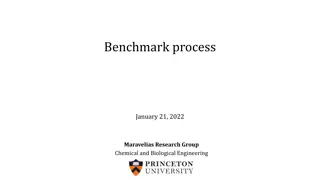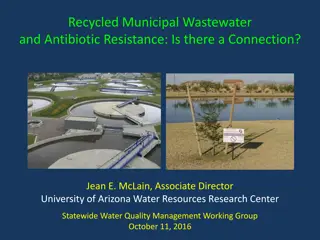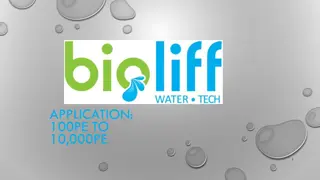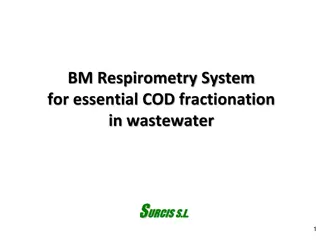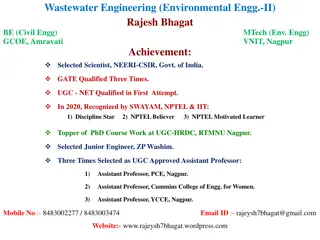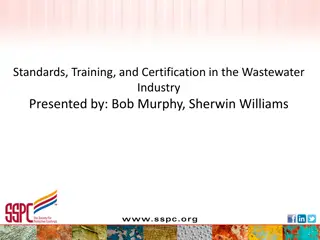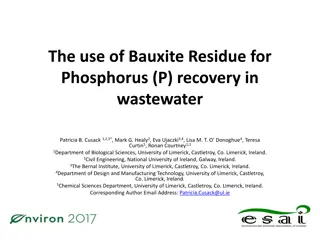Overview of Wastewater Collection and Treatment Systems
Explore the evolution of wastewater treatment processes, from Imhoff tanks to activated sludge systems. Learn about the history of sewage and stormwater collection, different types of pipes used, installation methods, and the importance of designing systems to combat diseases. Discover how processes like slow sand filtration, Imhoff tanks, trickling filters, and activated sludge contribute to removing organics and solids from wastewater.
Download Presentation

Please find below an Image/Link to download the presentation.
The content on the website is provided AS IS for your information and personal use only. It may not be sold, licensed, or shared on other websites without obtaining consent from the author.If you encounter any issues during the download, it is possible that the publisher has removed the file from their server.
You are allowed to download the files provided on this website for personal or commercial use, subject to the condition that they are used lawfully. All files are the property of their respective owners.
The content on the website is provided AS IS for your information and personal use only. It may not be sold, licensed, or shared on other websites without obtaining consent from the author.
E N D
Presentation Transcript
CTC 450 Review WW Collection Systems Sewage vs Storm Systems Types of pipes Installation 1
Objectives Understand basic processes for treating wastewater 2
Designing Against Disease Designing Against Disease http://www.tbp.org/pubs/Features/W10Bell.pdf Who graduated at age 15 from Dartmouth Thayer s School of Engineering? Allen Hazen (1869-1930) Slow sand filtration clarifies water. What else does it do? Removes 99% of bacteria What two design qualities are used to determine a material for filtration? Effective size and uniformity coefficient What percentage of the population in Chicago probably contracted typhoid in 1890-1892? 5% Who is considered the father of sanitary engineering in America? Hiram Mills (1836-1921)
WW Treatment Combination of physical and biological processes Processes are used to remove organics and solids (reduce BOD and SS) 4
History of Developing Processes Imhoff tanks used originally for settling of solids Treatment of water through gravel bed (1910) Activated sludge (1920s) RBC s (1959-Germany) 5
The Imhoff tank obtained its name from its inventor, Dr. Karl Imhoff of Germany. It is a variation of the septic tank in which two chambers are provided, one above the other. The upper sedimentation or flow chamber is for settling solids and the lower chamber is for anaerobic digestion of sludge. Solids settle to the bottom of the flow chamber passing through a slot at the bottom into the lower chamber. The slot is baffled in such a manner that gas rising from the lower chamber does not interfere with the sedimentation process in the upper chamber. A gas vent, known as the scum chamber, extends from the lower compartment up to the tank surface between the outside wall of the sedimentation chamber and the Imhoff tank enclosing wall. The main advantage of this type of tank over the septic tank is that sludge is separated from the effluent, which allows for more complete settling and digestion. Operated properly, these systems are capable of removing 30 to 60 percent of the suspended matter, and from 25 to 40 percent of the BOD. www.vnh.org/ PreventiveMedicine/Chapter7/7.08.ht ml 6
Trickling Filter http://upload.wikimedia.org/wikipedia/en/thumb/1/1b/Trickling_filter_bed_2_w.JPG/250px-Trickling_filter_bed_2_w.JPG 7
Activated Sludge http://www.steve.gb.com/science/biotransformation.html 8
Rotating Biological Contactor http://www.dmw.co.jp/english/temp/enban/enban-kata.html 9
Basic Processes-Municipal Primary Treatment Grit chamber Primary Settling Secondary Treatment Biological Treatment Final Settling Disinfection Contact Basin 10
Basic Processes-Small Aeration, Settling, Disinfection (no primary treatment) Series of Stabilization Ponds 12
Solids Treatment Solids are generated from primary settling and final settling Solids are usually treated via sludge digesters 13
Typical Effluent Quality Standards BOD and SS Max. monthly avg of < 30 mg/l (<.003% solids) pH between 6 and 9 Oil and grease < 10 mg/l 14
Design Loading Load (# s of BOD or SS) Flow (flow rates) Peak hourly flow, maximum monthly flow, annual average, average dry weather, average wet weather 15
Design Criteria for Various Treatment Processes Peak Hourly Flow Max. Monthly Flow Other Flow measurement X Bar Screen X Pumps X Min Hourly Flow Grit Chamber X X Primary Settling X Final Settling X Disenfection X
Preliminary Treatment Flow is measured (Parshall flume) Screening (1/2 or 1 spacing) (with grinder or shredder- size) Grit Chamber (sand; coffee grounds) 17
A Parshall flume is a specially shaped structure which can be installed in a channel to measure the water flow rate. The flume was developed and calibrated by Ralph Parshall at Colorado State University early in this century and has been used extensively. Although Parshall flumes are difficult devices to set and build, they are an accepted and widely used measuring device. waterknowledge.colostat e.edu/ parshall.htm 18
Grit Chamber - client.greeley-hansen.com/. ../pue02-03pics.htm 22
Other Ways to remove grit Removal in primary clarifier Aerated units w/ hopper bottoms https://www.hoffmanandlamson.com/en-us/industries/water-and-wastewater- treatment/aerated-grit- chamber#:~:text=An%20aerated%20grit%20removal%20system,out%20of%20the %20water's%20streamline Forced vortex tanks (proprietary) https://esemag.com/wastewater/implementing-vortex-grit-removal- right-way/ 23
Grit Removal Trivia The recommended velocity of a properly operated grit removal system is 1 foot per second. This velocity allows the grit to settle but the majority of the organics to remain suspended. 24
Clarifiers (settling/sedimentation tanks) Primary (before biological treatment) Intermediate (in between biological treatments) Final (following biological treatment) 25
Primary Clarifiers Primary Clarifier Pond www.nwlink.com www.cityofweirton.com/ wsb/treatment.htm 27
Design Criteria for Primary Clarifiers See class handout (my website-schedule) Overflow rates Side water depth Weir loading Notes: Includes EPA standards and Standards based on a report of the WW Committee of the Great Lakes Note: Secondary solids --- activated sludge solids are returned to the primary for removal with primary solids 29
Description Two primary settling tanks are 95 ft in diameter w/ a 7 side water depth. Single effluent weirs are located on the peripheries of the tanks. For an average design flow of 10.0 mgd and peak flow of 15.4 mgd calculate the overflow rate, detention time and weir loading 31
Calculate Overflow rate Surface area of 2 tanks = 14,200 ft2 Volume (7 ) depth=99,400 ft3 =0.744 million gal. Overflow rate=Q/A=704 gpd/ft2(avg design flow) Overflow rate=1084 gpd/ft2 (peak flow) Check that values are less than design stds (average)---Okay Average EPA 800-1200 gpd/square ft Average Great Lakes Standards 1000 gpd/square ft Check that values are less than design stds (peak)----Okay Peak EPA 2000-3000 gpd/square ft Average Great Lakes Standards 1500 gpd/square ft 32
Calculate Detention Time Vol/Q=(0.744E6 gallons/10 mgd)*24 hr/day =1.8 hours (average design flow) Note: Can also use H/Vo (depth of water/overflow rate) 33
Calculate Weir Loading Weir length for 2 tanks = 2*pi*D=2*pi*95 ft=597 ft Weir loading = Q/weir length= 10E6 gpd/597 ft =16,750 gpd/ft (check standards---see below) Okay per EPA standards (10,000-40,000 gpd/ft) but not for Great Lake standards (10,000 gpd/ft) Could add a 2nd set of weirs to get to 8,400 gpd/ft 34
Check Side Water Depth Side Water Depth = 7 Not okay per EPA standards (10-13 ft) Okay per Great Lakes standards (7 ) 35
Intermediate Clarifier Sometimes used for 2-stage secondary treatment processes: Between 2 trickling filters Between trickling filter and activated sludge Typical Values: Overflow rate 600-800 gpd/sq ft Minimum water depth should be 10 ft Weir loading: 10,000 to 20,000 gpd/linear ft 36
Final or Secondary Clarifiers There are differences in sludge characteristics between trickling filters and activated sludge: Design of final clarifiers following trickling filters is similar to design of primary clarifiers Design of clarifiers following activated sludge systems must take into account the reduced settleability. Deeper Lower overflow rate Longer weir length 37
Final Clarifiers-After TF vs After AS Settles Readily Less buoyant Depth a few inches Sludge is removed less frequently Tank not as deep Hard to Settle Lighter, more buoyant Depth 1 to 2 feet Rapid, uniform sludge withdrawal is ideal Tank is usually deeper 38
Description Determine the recommended size of two new circular secondary clarifiers for an activated sludge system w/ a design flow of 20,000 m3/day with a peak hourly flow of 32,000 m3/day. Use maximum overflow rates of 33 m3/m2-day at design monthly flow and 66 m3/m2-day at peak hourly flow. 40
Calc Required Surface Area & Tank Diameter Design Monthly Flow Required Surface area = Design flow Rate/Maximum Overflow Rate =20,000/2*33=303 square meters Assuming 2 tanks, calculate the diameter=19.6 meters 41
Check Peak Overflow Rate Peak Flow Required Surface area = Peak flow Rate/Maximum Overflow Rate =32,000/2*66=242 square meters Assuming 2 tanks, calculate the diameter=17.6 meters Use worst case: Diameter must be 19.6 meters 42
Example 11-2 Check Weir Loading Assuming the inboard weir channel is set on a diameter of 20 meters Weir loading=Q/weir length =32,000/(pi*19.6 m*2 tanks)=260 m3/m2-day (Maximum is 125 to 250; design is just over maximum) 43
Side Water Depth The recommended side water depth for a tank diameter between 50 and 100 feet is 11 ft (reference was prior book) 44
Review Question What are two types of solids effectively removed by primary clarifiers? A. Floatable and settleable B. Floatable and dissolved C. Dissolved and colloidal D. Suspended and organic 45
Review Questions What are the differences between a primary, intermediate and final clarifier? What can be used to measure the incoming flow rate? 46
